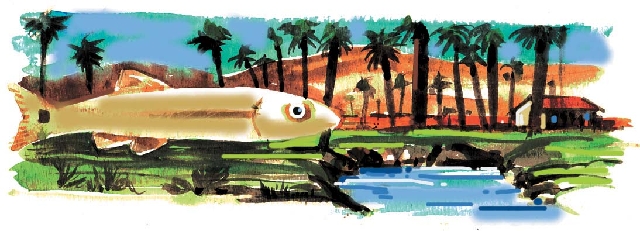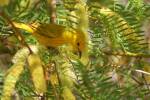Moapa Valley Wildlife Refuge protects rare fish
The Moapa Valley National Wildlife Refuge — the smallest of the four protected areas that constitute the Desert National Wildlife Refuge Complex — includes 116 acres surrounding several natural warm springs that feed the Muddy River. The little-known oasis protects one of the rarest fish on Earth, the diminutive Moapa dace, as well as several other endangered species of plants, animals, birds and insects.
The refuge is about an hour’s drive from Las Vegas. Follow Interstate 15 north about 50 miles to the Glendale/Moapa turnoff onto Route 168 at exit 90. Drive west for 7.4 miles to Warm Springs Road, a short loop off the main highway. Follow this quiet rural route for about a mile and a half to the refuge entrance on the left.
Warm Springs Road used to bustle with traffic when two popular private swimming resorts drew visitors seeking relief from the desert heat. Generations of Southern Nevadans drove to Warm Springs for its picnic areas shaded by palm trees, warm-water swimming pools, bathing pavilions, camping areas and RV facilities. Youngsters puddled in the creeks, often pursuing darting “minnows,” which were actually full-grown examples of the Moapa dace, a small desert fish.
The resort facilities are now a thing of the past. The oasis has been a wildlife refuge since 1979.
The refuge is open to the public Fridays through Sundays from sunrise to sunset from Labor Day through Memorial Day. There is no entrance fee.
Volunteers and staff provide information and conduct programs for visitors. Program schedules include special events such as a recent photography workshop, night-sky observance session with local astronomy experts and demonstrations with live birds of prey.
Next to the refuge’s parking area are Southwestern-styled structures including a shelter for picnicking and group activities and restrooms. Several paved or gravel trails provide access to the area, including its main feature, a glass-fronted outdoor aquarium built into one of the springs. The aquarium creates a window into the aquatic habitat of the Moapa dace, the White River springfish and other tiny creatures native only to the warm-water springs and streams of the Upper Muddy River system, an area covering about two miles.
Under federal management of the refuge, habitat enhancement is crucial to the preservation of the endangered species. Efforts are ongoing to control proliferation of introduced plants such as the palms and tamarisk and non-native fish.
Because their dense mats of roots impede free-running natural creeks, the palms closest to the water were removed. Prone to wildfires, overgrown stands of palms have been thinned. Native plants and trees have been planted. Man-made structures have been removed.
Natural water flow is enhanced by careful placement of rocks and logs to create protected places for the fish to feed, mate and spawn and for the fry to grow into silvery 2-inch-long adult dace.
The latest count recorded an increase in the dace population, but they are still far from being out of danger.
The improved native habitat also attracts many desert animals and a wide variety of birds, some resident and others just passing through. Some of these native creatures would never have approached when the area was developed into a resort and attracted crowds of people.
This little refuge adds to the variety of unique birding and wildlife observation opportunities available in Southern Nevada.
Visitors to the Moapa Valley National Wildlife Refuge meet volunteers who generously share their knowledge, information and photographs. These amateur and professional naturalists continue to document the fish, animals and insects attracted to the oasis. They stock a little backpack with guidebooks, binoculars, bird lists and note pads for use while visiting the refuge, equipment particularly appealing to school-age youngsters.
Pack a picnic lunch and plan to spend a little time at the refuge. Enjoy the quiet of this secluded spot and take time to look around. Visitors young and old will find they return home with greater appreciation for the natural world around us.
Margo Bartlett Pesek’s column appears on Sundays.




























